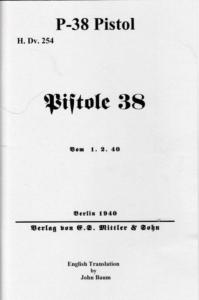
By Jim Dickson | Contributing Writer
Original 1940 German Army manual on the Walther P38 pistol translated by and available from:
John A. Baum
5678 State Rt. 45
Lisbon, Ohio 44432
Price including shipping $11
One of the iconic pistols of WW2 the Walther P38 has seen much use in America since the war and now users can avail themselves of the original German Army manual on this pistol translated into English.
In true German fashion the gun is thoroughly covered. It’s safe handling, shooting, disassembly and reassembly are detailed.
As this is a field manual it did not go past field stripping but the translator has thoughtfully added that discussion at the rear to help any gunsmith needing to install new parts. His comments on which parts one should avoid totally taking apart if possible can save you a lot of grief. If you do need to take them apart he includes all the tricks of the trade you need to know. The role of every part involved in the firing cycle is detailed as well as cautions on disassembly and shooting to insure the user’s success.
Like all German manuals, it contains a troubleshooting section detailing what can go wrong and the cause and corrective action. This in itself is priceless to the shooter unaccustomed to troubleshooting problems.
There is also a section detailing the 9MM Parabellum’s range and penetration in various mediums and distances which gives a far clearer idea of what the cartridge is capable of than most any other source. I am a firm believer in using the military manuals on guns and there will be few people who can’t learn something new about the P38 from this manual.
The P38 was one of the most influential pistols of its day affecting handgun design down to the present. One misunderstood point is the true reason behind its double-action trigger, which was to enable the shooter to safely drop the hammer multiple times on a hangfire without risking damage to his hand should the cartridge unexpectedly go off. The last thing you want to have happen is the cartridge to suddenly go off while you are thumbing the hammer back and have the slide hit your thumb. That can do more damage than you might imagine and hangfires were more common in the first part of the 20th Century than most people today realize.
The memory of such failures to fire during the First World War was still a fresh scar on the world’s ordnance departments and the double action trigger was Germany’s solution just as the cocking piece on the U.S. Krag and Springfield rifles was America’s solution. You certainly don’t want the bolt of your rifle unlocked just as a hangfire decides to go off.
The P38 was always intended to be used as a single action automatic when fired due to the virtual impossibility of the shooter making a fast double action first shot followed by a fast second shot single action and still hit the target. Most men simply cannot do it for it is an unnatural movement.
Like all Walther pistols the P38 is a natural pointer and gives good service. To get the most out of any gun you need to fully understand it though and nothing does that better than a German Army manual.




